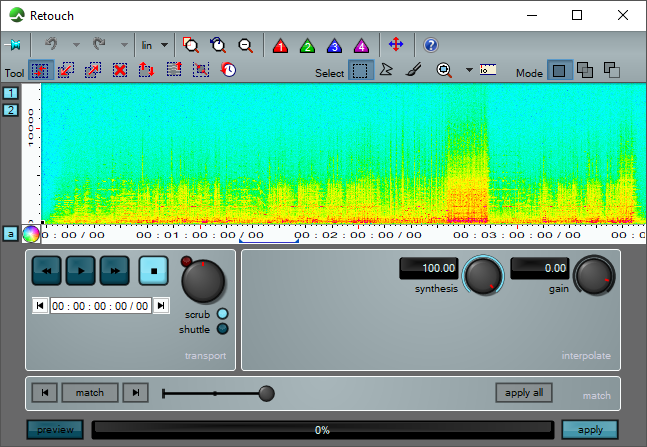Retouch™

When it was introduced, Retouch was a huge leap forward in sound processing technology. Unlike conventional restoration tools, it provided a wide range of time/frequency editing (TFE™) capabilities, and allowed you to define the temporal and spectral content of the sound you wanted to remove. Nowadays, it allows you to mark and process complex areas in its spectrogram using the types of tools commonly found in powerful photographic and image manipulation software. This makes it possible to identify all manner of sounds and noises which can then be manipulated using any of the processing tools at your disposal.
Matching
Using machine learning to identify problems...
There are many occasions when you will encounter similar instances of unwanted sounds in a track - things such as hi-hat spill in a multi-track recording, over-excited sibilants and plosives in a vocal track, or even the repetitive noise caused by a piece of machinery in the background. Traditionally, one would remove these sounds by identifying each event individually and then defining it manually prior to processing. But this is time consuming... sometimes very time consuming. So wouldn't it be nice if your spectral repair tool could look at the first instance that you identified and then go on to find all of the others? Well, it can.
Match allows you to mark one of the offending sounds and then ask the machine learning algorithm in Retouch to find all of the other instances within the recording. A threshold control even allows you to bias its decision making toward including more or fewer possibilities so that you can find the level that includes everything that you want to remove but precludes events that seem similar but are actually wanted signal.
Having identified all of the matches, you can then eliminate them using the approporiate Retouch tool. You can process them individually, authorising and applying the chosen tool to each, or you can process all of the matches as a group, whereupon Retouch will fly through the whole file in a tiny fraction of the time needed with human intervention. The increase in productivity is absolutely remarkable.
The Tools
Interpolate
• suppresses or removes problem sounds seamlessly.
Copy and Patch
• allows you to replace areas of audio with more suitable audio from elsewhere. These tools are invaluable when working with atmos and they also include a pitch shifting algorithm that takes into account the relative pitch of components within the audio selection, greatly aiding the correction of harmonically rich material and even allowing you to correct the pitches of incorrect notes within musical material.
Erase
• eliminates unwanted audio quickly and accurately.
Volume
• allows you to listen to just the marked sounds, or everything but the marked audio.
Repair
• puts the AI into Spectral Repair, allowing you to affect the amplitude of loud events within a marked region without affecting the lower level signal and noise within that region. There are endless uses for this including noise elimination, clarifying sounds, or simply mixing an event more appropriately within the overall signal. More details here.
Cleanse
• is another patented process that allows you to isolate sounds such as wanted speech in the presence of strong, but relatively short-lived background noises such as gusts of wind blowing across a microphone.
History
• allows you to define any part of the spectrogram and return it to its original, unprocessed form. This allows you to reinitialise or step back through the history of any part of the audio no matter where it came in the process history, thus leaving later work untouched.
In short...
With its enhanced capabilities, Retouch stands alone as the spectral editor of choice for mastering studios, mix suites, post houses, forensic laboratories, and anyone else who needs to be able to identify, isolate and manipulate individual sounds within an audio file.
When all else fails... Retouch gives you complete control.